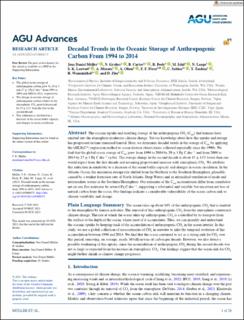| dc.contributor.author | Müller, Jens Daniel | |
| dc.contributor.author | Gruber, N. | |
| dc.contributor.author | Carter, B. | |
| dc.contributor.author | Feely, R. | |
| dc.contributor.author | Ishii, M. | |
| dc.contributor.author | Lange, N. | |
| dc.contributor.author | Lauvset, Siv Kari | |
| dc.contributor.author | Murata, A. | |
| dc.contributor.author | Olsen, Are | |
| dc.contributor.author | Pérez, F.F. | |
| dc.contributor.author | Sabine, C. | |
| dc.contributor.author | Tanhua, T. | |
| dc.contributor.author | Wanninkhof, R. | |
| dc.contributor.author | Zhu, D. | |
| dc.date.accessioned | 2023-09-22T06:40:19Z | |
| dc.date.available | 2023-09-22T06:40:19Z | |
| dc.date.created | 2023-09-20T13:07:51Z | |
| dc.date.issued | 2023 | |
| dc.identifier.citation | AGU Advances. 2023, 4 (4), . | en_US |
| dc.identifier.issn | 2576-604X | |
| dc.identifier.uri | https://hdl.handle.net/11250/3091239 | |
| dc.description.abstract | The oceanic uptake and resulting storage of the anthropogenic CO2 (Cant) that humans have emitted into the atmosphere moderates climate change. Yet our knowledge about how this uptake and storage has progressed in time remained limited. Here, we determine decadal trends in the storage of Cant by applying the eMLR(C*) regression method to ocean interior observations collected repeatedly since the 1990s. We find that the global ocean storage of Cant grew from 1994 to 2004 by 29 ± 3 Pg C dec−1 and from 2004 to 2014 by 27 ± 3 Pg C dec−1 (±1σ). The storage change in the second decade is about 15 ± 11% lower than one would expect from the first decade and assuming proportional increase with atmospheric CO2. We attribute this reduction in sensitivity to a decrease of the ocean buffer capacity and changes in ocean circulation. In the Atlantic Ocean, the maximum storage rate shifted from the Northern to the Southern Hemisphere, plausibly caused by a weaker formation rate of North Atlantic Deep Waters and an intensified ventilation of mode and intermediate waters in the Southern Hemisphere. Our estimates of the Cant accumulation differ from cumulative net air-sea flux estimates by several Pg C dec−1, suggesting a substantial and variable, but uncertain net loss of natural carbon from the ocean. Our findings indicate a considerable vulnerability of the ocean carbon sink to climate variability and change. | en_US |
| dc.language.iso | eng | en_US |
| dc.rights | Navngivelse 4.0 Internasjonal | * |
| dc.rights.uri | http://creativecommons.org/licenses/by/4.0/deed.no | * |
| dc.title | Decadal Trends in the Oceanic Storage of Anthropogenic Carbon From 1994 to 2014 | en_US |
| dc.title.alternative | Decadal Trends in the Oceanic Storage of Anthropogenic Carbon From 1994 to 2014 | en_US |
| dc.type | Peer reviewed | en_US |
| dc.type | Journal article | en_US |
| dc.rights.holder | © 2023. The Authors | en_US |
| dc.description.version | publishedVersion | en_US |
| cristin.ispublished | true | |
| cristin.fulltext | original | |
| cristin.qualitycode | 1 | |
| dc.identifier.doi | 10.1029/2023AV000875 | |
| dc.identifier.cristin | 2177073 | |
| dc.source.journal | AGU Advances | en_US |
| dc.source.volume | 4 | en_US |
| dc.source.issue | 4 | en_US |
| dc.source.pagenumber | 0 | en_US |

